"Understanding Early Humans: Evolution, Society, and Culture"
Early Humans
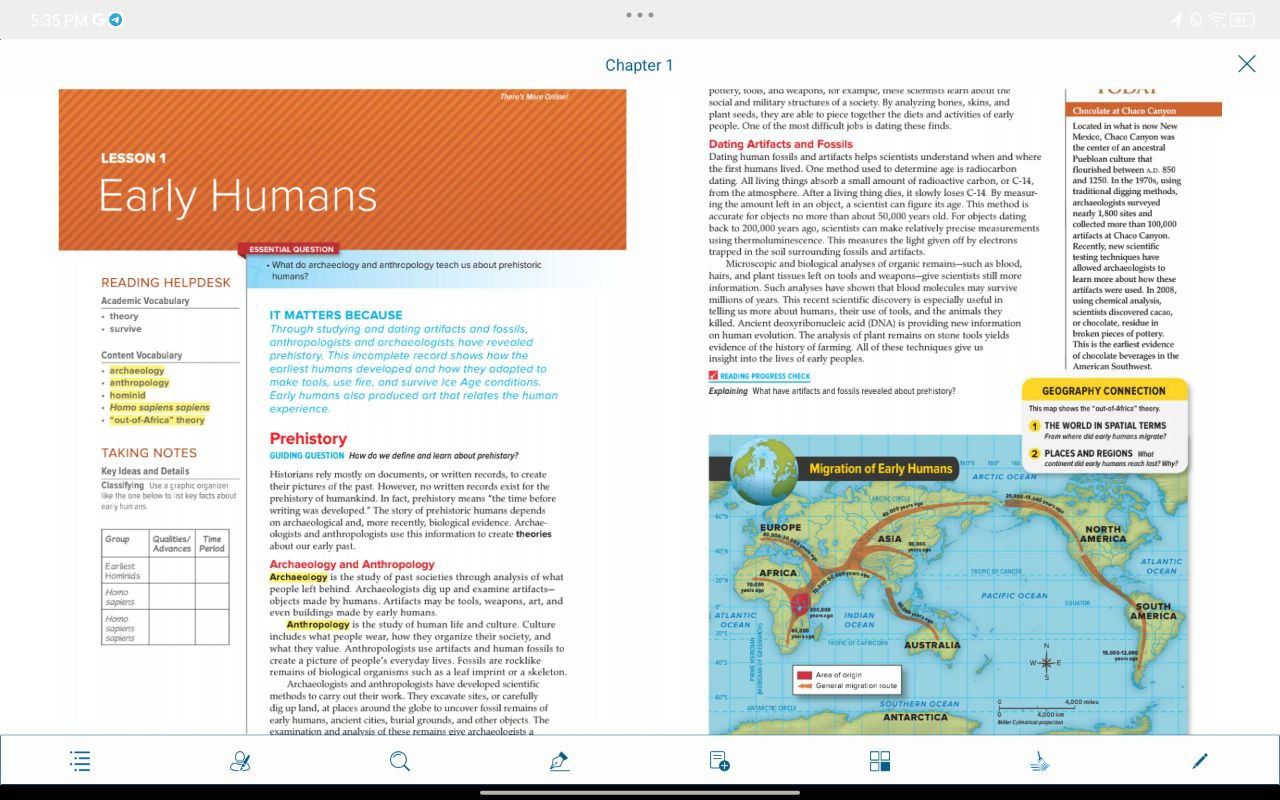
Reading Helpdesk
- Academic Vocabulary
- theory: A well-substantiated explanation of an aspect of the natural world.
- Thoughts: Theories in anthropology help us understand human evolution and behavior by providing frameworks for interpreting archaeological and fossil data.
- survive: To continue to live or exist, especially in spite of danger or hardship.
- Additional Info: Survival is crucial for species, as it relates to adaptation to environments and the development of societal structures.
- theory: A well-substantiated explanation of an aspect of the natural world.
Content Vocabulary
-
archaeology: The study of human history and prehistory through excavating sites and analyzing artifacts.
- Thoughts: Archaeology is essential for reconstructing human pasts and understanding cultural evolution.
-
anthropology: The study of humans, their behavior, and societies in the past and present.
- Thoughts: This field often overlaps with archaeology, providing a broader context for human development.
-
hominid: Any member of the biological family Hominidae, including modern humans, their ancestors, and relatives.
- Additional Info: Understanding hominids helps trace human evolution and adaptations over millions of years.
-
Homo sapiens sapiens: The subspecies of Homo sapiens to which all modern human beings belong.
- Thoughts: This classification emphasizes the distinct behaviors, culture, and physical traits that set modern humans apart from earlier hominids.
-
"out-of-Africa" theory: The hypothesis that modern humans originated in Africa and migrated outwards to populate the rest of the world.
- Additional Info: Genetic and archaeological evidence supports this theory, showing a common ancestry traced back to Africa.
Taking Notes
Guiding Question: How do we define and learn about prehistory?
- Historians' Methods: Historians rely on artifacts and written records to reconstruct the past.
- Thoughts: The lack of written records from prehistoric times makes archaeology vital to understanding early human life.
Archaeology and Anthropology
- Archaeology: The study of past societies through artifacts and excavations.
- Thoughts: This approach provides tangible evidence of human activities and societal structures.
| Term | Definition |
|---|---|
| Archaeology | Study of human history through artifacts and excavation. |
| Anthropology | Study of human behavior and societies in the past and present. |
| Hominid | Members of the family Hominidae, which includes modern humans and their ancestors. |
| Homo sapiens sapiens | Modern humans, characterized by advanced cognitive abilities and culture. |
| "Out-of-Africa" Theory | Hypothesis proposing that modern humans originated in Africa before migrating globally. |
Dating Artifacts and Fossils
-
Importance of Dating: Assessing human fossils and artifacts aids scientists in understanding human evolution.
- Thoughts: Accurate dating is crucial for constructing timelines of human development and migration.
-
Methods Used:
- Radiocarbon dating (C-14): Measures the decay of carbon in organic materials.
- Thermoluminescence: Used for dating when fossil artifacts are thermally stimulated.
Geography Connection
- Migration Patterns: A visual representation of early human migration from Africa to other continents.
- Thoughts: Understanding these patterns helps in tracing human adaptation to diverse environments and developments across cultures.
Summary
The section provides an overview of early human studies through archaeology and anthropology, emphasizing the importance of examining artifacts to gain insights into prehistoric life, society, and migration. The "out-of-Africa" theory is discussed as a crucial concept in understanding human evolution.
Extended readings:
Early Development and The Paleolithic Age
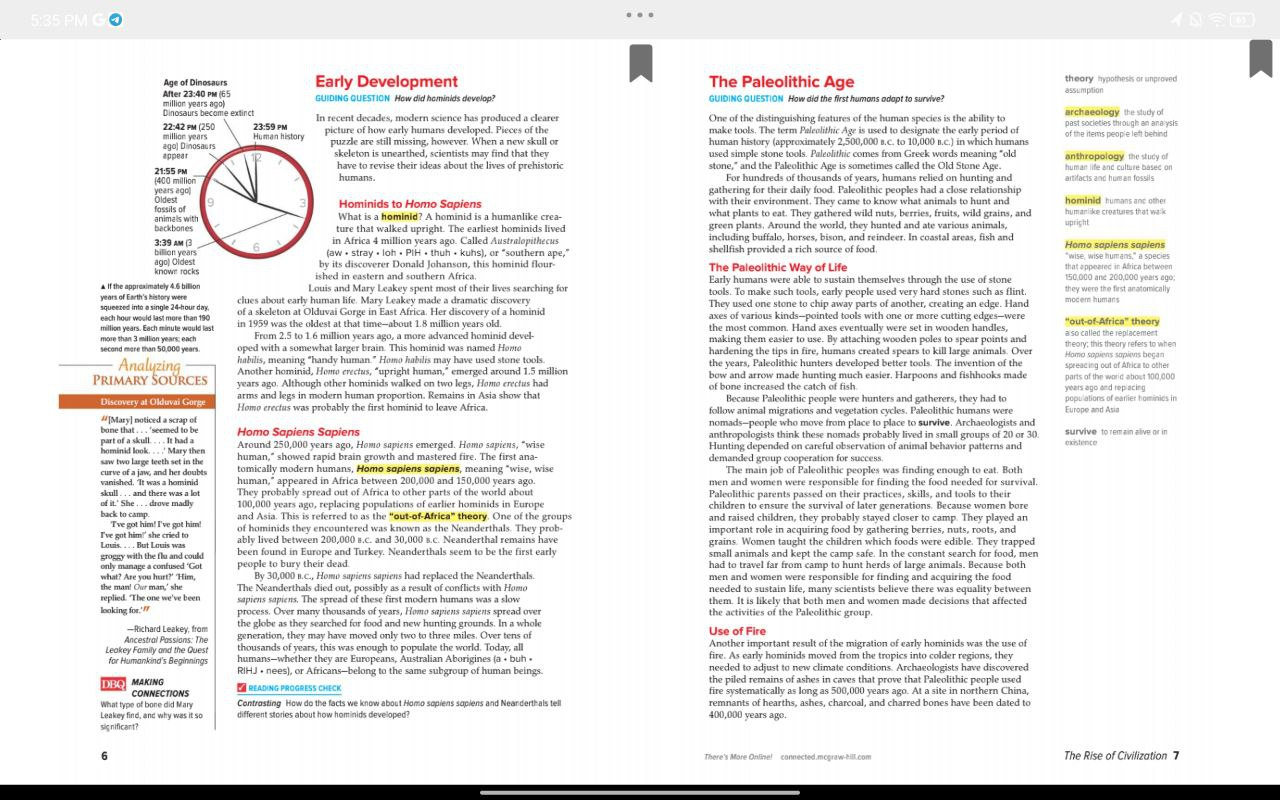
Early Development of Hominids
-
Hominids to Homo Sapiens:
- Hominids are a family of species that includes humans.
- The earliest known hominids lived in Africa around 4 million years ago, such as Australopithecus.
- These species walked upright and were a significant step in human evolution.
-
Discovery of Hominids:
- In 1959, a major discovery was made at Olduvai Gorge in East Africa, uncovering a hominid skeleton estimated to be about 1.8 million years old.
- This skeleton was named Homo habilis, and marked significant progress in the understanding of human ancestry.
Homo Sapiens Sapiens
-
Emergence:
- Approximately 250,000 years ago, Homo sapiens, meaning "wise humans," emerged.
- Homo sapiens sapiens, the direct ancestors of modern humans, appeared between 200,000 and 150,000 years ago.
- This species is known for its superior tool-making and adaptability compared to earlier hominids.
-
Migration Theories:
- The "out-of-Africa" theory suggests that Homo sapiens migrated from Africa to other parts of the world.
- This migration led to the spread of different populations, adapting to various environments.
The Paleolithic Age
-
Characteristics:
- The Paleolithic Age is defined as the period of human history where stone tools were primarily crafted and used.
- Humans were generally nomadic, living in small groups and relying on hunting and gathering for sustenance.
-
Hunting and Gathering:
- Early humans relied on available resources.
- They formed strategies for hunting and gathering, which included social cooperation, like planning hunting trips and sharing food.
- Tools like spears and fishing hooks evolved to aid in gathering.
-
Use of Fire:
- One key advancement was the control of fire, which provided warmth, protection, and a means to cook food.
- Fire also played a central role in social settings, as it gathered groups together, facilitating communal activity.
Summary of Key Points
- The transition from early hominids to Homo sapiens took millions of years, marked by significant discoveries and evolutionary developments.
- The adaptation of early humans to their environment was crucial for survival, influenced by their social structures, innovation in tools, and ability to migrate.
Theoretical Background
- Archaeology: The study of ancient cultures through material remains.
- Anthropology: The study of human societies and their development over time.
Migration Information in Tabular Format
| Time Period | Species | Locations |
|---|---|---|
| 250,000 years ago | Homo sapiens | Africa |
| 200,000 - 150,000 years ago | Homo sapiens sapiens | Migration to Europe and Asia |
| 30,000 years ago | Neanderthals | Europe |
This summary encapsulates the evolution of early hominids to Homo sapiens and the implications during the Paleolithic Age.
Extended readings:
The Neolithic Revolution
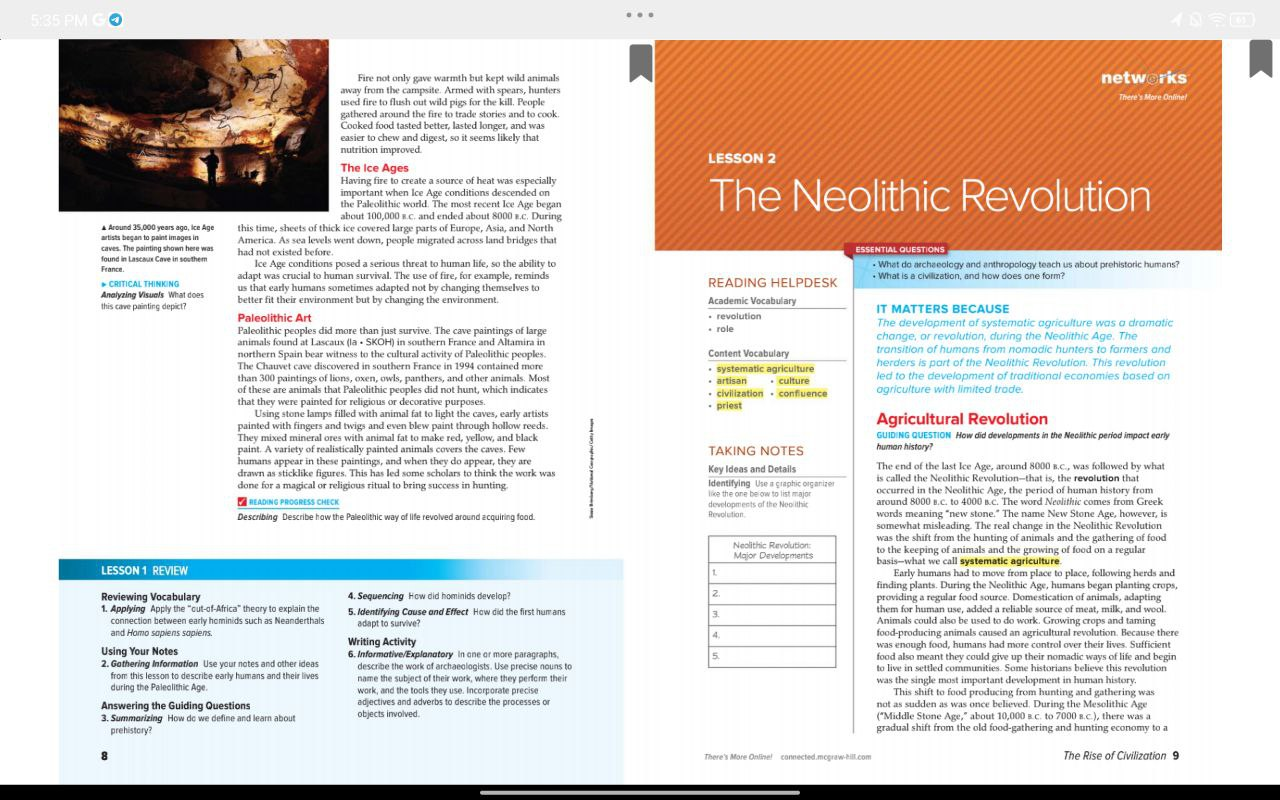
Key Topics and Ideas
-
Neolithic Revolution
- The Neolithic Revolution marks a significant turning point in human history, transitioning from nomadic lifestyles to settled farming communities. This transformation allowed for increased food production, leading to population growth and the development of civilization.
-
Agricultural Revolution
- The shift from hunting and gathering to agriculture during the Neolithic Period was fundamental. By cultivating crops and domesticating animals, communities could sustain themselves year-round, reducing the need for constant movement.
- With agriculture, humans began to establish permanent settlements, which fostered the growth of larger, more organized societies.
-
Role of Fire
- Fire was a crucial element in human development, providing warmth, protection, and a means to cook food. Cooking not only made food more palatable but also safer to eat, ensuring better nutrition and health outcomes.
-
Paleolithic Art
- Paleolithic art, such as cave paintings, reflects the culture and beliefs of prehistoric humans. These artworks often depicted hunting scenes and animals, giving insight into the daily life and spiritual practices of these early people.
-
Importance of Adaptation
- The ability to adapt to changing environments, such as utilizing available resources effectively (like art and fire), was essential for survival. This adaptability laid the groundwork for future innovations in agriculture and society.
Table: Key Vocabulary
| Academic Vocabulary | Content Vocabulary |
|---|---|
| revolution | systematic agriculture |
| role | artisan |
| culture | |
| civilization | |
| priest | |
| confluence |
Summary of Additional Information
- The end of the last Ice Age, around 8000 B.C., coincided with the start of the Neolithic Revolution. This period marked a shift in climate and environment that made agriculture more feasible.
- The development of farming allowed for the establishment of complex societies and eventually the rise of cities, which had a lasting impact on human history.
- Neolithic societies became more interdependent due to trade, leading to cultural exchanges and innovations that shaped civilization's trajectory.
Extended readings:
Neolithic Farming and the Spread of Systematic Agriculture
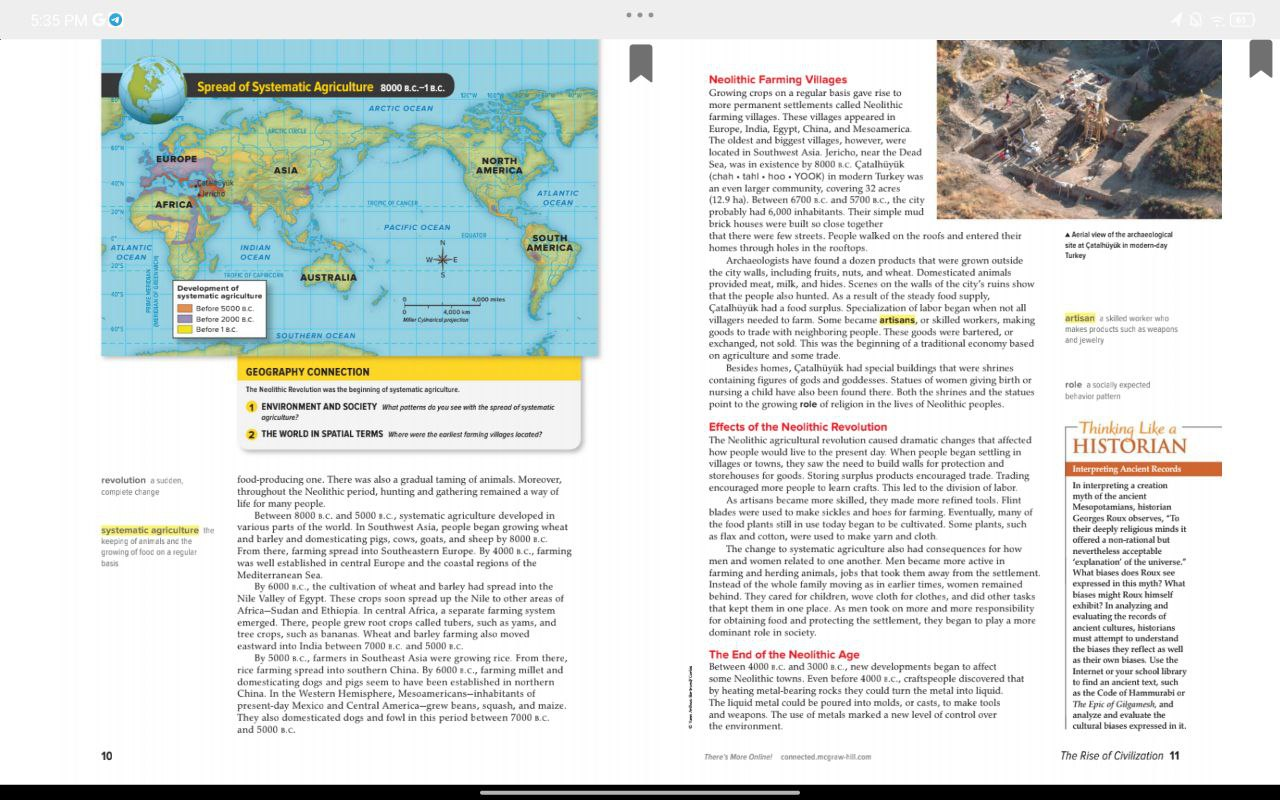
Spread of Systematic Agriculture
- Timeline: The spread of systematic agriculture is noted between 8000 B.C. and 1 B.C., indicating significant agricultural development during this period.
- Regions: Agriculture developed independently in various regions including Europe, Asia, Africa, and the Americas.
- Thoughts: This illustrates the varied adaptation and innovation of farming techniques across different climates and cultures. It suggests a need for food security drove these advancements.
| Development of Systematic Agriculture | Time Period |
|---|---|
| Before 8000 B.C. | Earliest agriculture |
| 8000 B.C. to 5000 B.C. | Development phase |
| 5000 B.C. to 2000 B.C. | Expansion phase |
| After 2000 B.C. | Further diversification |
Neolithic Farming Villages
- Characteristics: Neolithic villages marked a shift from nomadic lifestyles to sedentary living, allowing for permanent settlements.
- Example: Çatalhöyük (ca. 6700 to 5700 B.C.) in modern-day Turkey had a population of approximately 6,000, characterized by close-knit community structures.
- Thoughts: This marks the beginnings of urbanization, where people began living in larger groups, leading to the development of social structures and cultures.
Effects of the Neolithic Revolution
- Agricultural Changes: The Neolithic Revolution transformed human lifestyles through farming, introducing new ways of living and social organization.
- Storage and Trade: The need to store surplus food led to trade expansion, impacting societal development.
- Thoughts: Trading not only helped with the survival of communities but also fostered interactions between different cultures, leading to the exchange of ideas and technologies.
The End of the Neolithic Age
- Crisis and Change: By 3000 B.C., new developments began to impact established communities, including environmental changes and population expansions.
- Impact of Metal Tools: The emergence of metallurgy changed farming practices and trade, marking a technological shift in societies.
- Thoughts: These transitions reflect the resilience of human societies as they adapt to changes in their environment and technologies, paving the way for the rise of civilizations.
Key Terms
- Artisan: A skilled worker who creates goods such as tools and jewelry, emphasizing the division of labor that arose during and after the Neolithic period.
- Neolithic Revolution: A critical point in human history where agriculture began, leading to larger societies and complex social structures.
Overall, the image discusses the profound changes brought on by the advent of agriculture, setting the foundation for the rise of civilization and social complexity in human history.
Extended readings:
Civilization Emerges
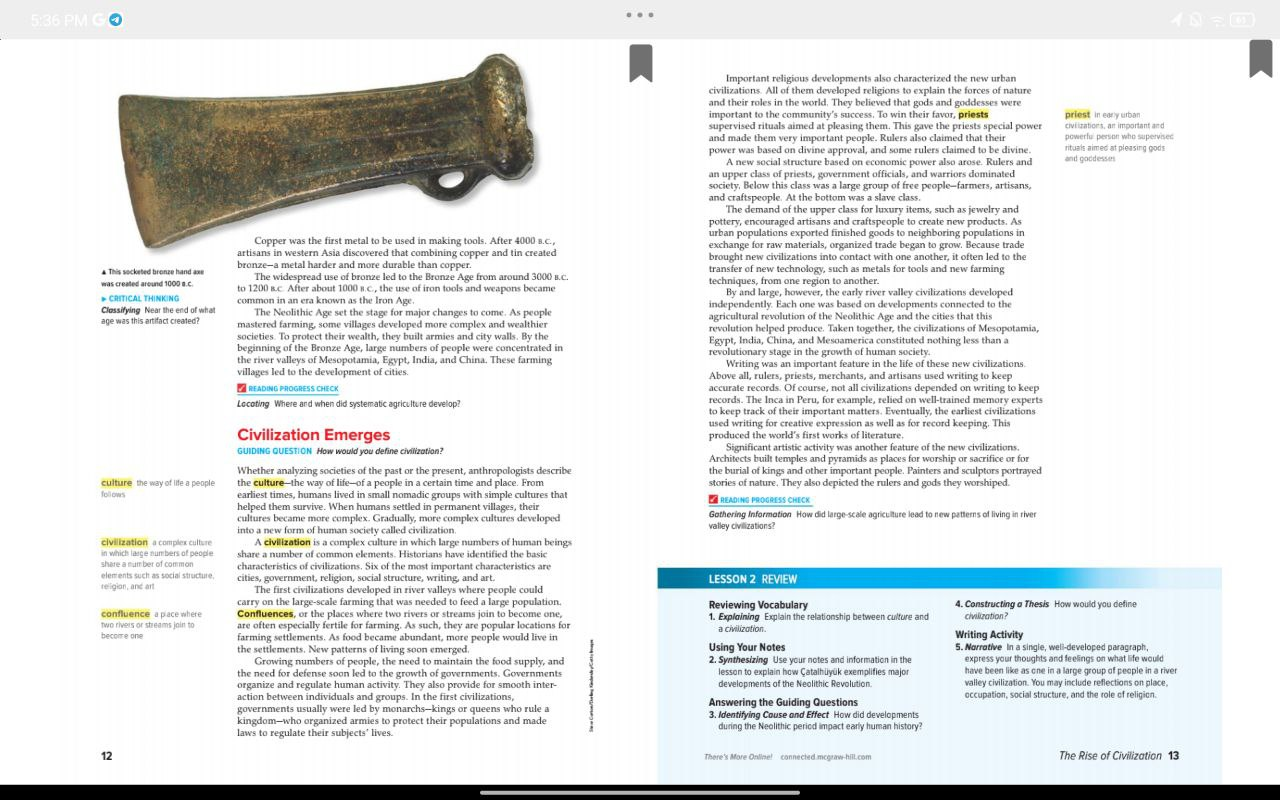
Key Concepts
-
Copper and Bronze Age
- Copper was the first metal used in tools around 4000 B.C.
- After 4000 B.C., artisans discovered combining copper with tin created bronze, which was stronger.
- The transition to the Bronze Age is marked around 3000 B.C., leading to significant advancements in tools and weapons.
- Thoughts: This technological leap facilitated improved farming techniques, arms development, and trade.
-
Agricultural Development and Urbanization
- As people mastered farming, they started building more complex societies.
- The increase in agricultural production led to population concentrations near river valleys (e.g., Mesopotamia, Egypt, India, and China).
- Idea: The establishment of farming villages was crucial for the rise of cities. These areas became centers of trade and culture.
-
Religion and Governance
- Societies developed religions to explain natural phenomena and establish community cohesion.
- Rulers claimed divine approval, and an upper class of priests emerged.
- Additional Info: This hierarchy increased the demand for luxury goods, creating networks for trade and craftsmanship.
-
Civilization Defined
- A civilization is a complex culture where large numbers of humans share a common element such as government, religion, and art.
- Reflection: The development of writing systems was essential for record-keeping and governance.
-
Confluence of Rivers
- River confluences became central to civilization because they provided resources, trade routes, and fertile land.
- Interesting Note: This geographical advantage led to more prosperous settlements, which often developed unique cultural traits.
Review Questions
-
How would you define civilization?
- A civilization represents a societal structure where culture, politics, economy, and social complexities are interconnected.
-
How did large-scale agriculture lead to new patterns of living in river valley civilizations?
- It facilitated stable food supplies, increased population density, and the need for organized governance, leading to city-states.
Lesson 2 Review
-
Reviewing Vocabulary
- Explaining: Define the relationship between culture and civilization.
- Synthesizing: Use notes and information to illustrate the key developments of the Neolithic Revolution.
-
Using Notes
- Provide real-world examples of these evolutions as they connect to river valley civilizations.
-
Constructing a Thesis
- Reflect on how civilizations emerge from shared economic, religious, and political practices.
-
Narrative Activity
- Explore personal stories or reflections on life in a historical river valley civilization, including perspectives on occupation and social structure.
These notes consolidate key ideas about the emergence of civilizations, their cultural dynamics, and the significant role of agriculture, trade, and governance in shaping human societies.
Extended readings:
Mesopotamia
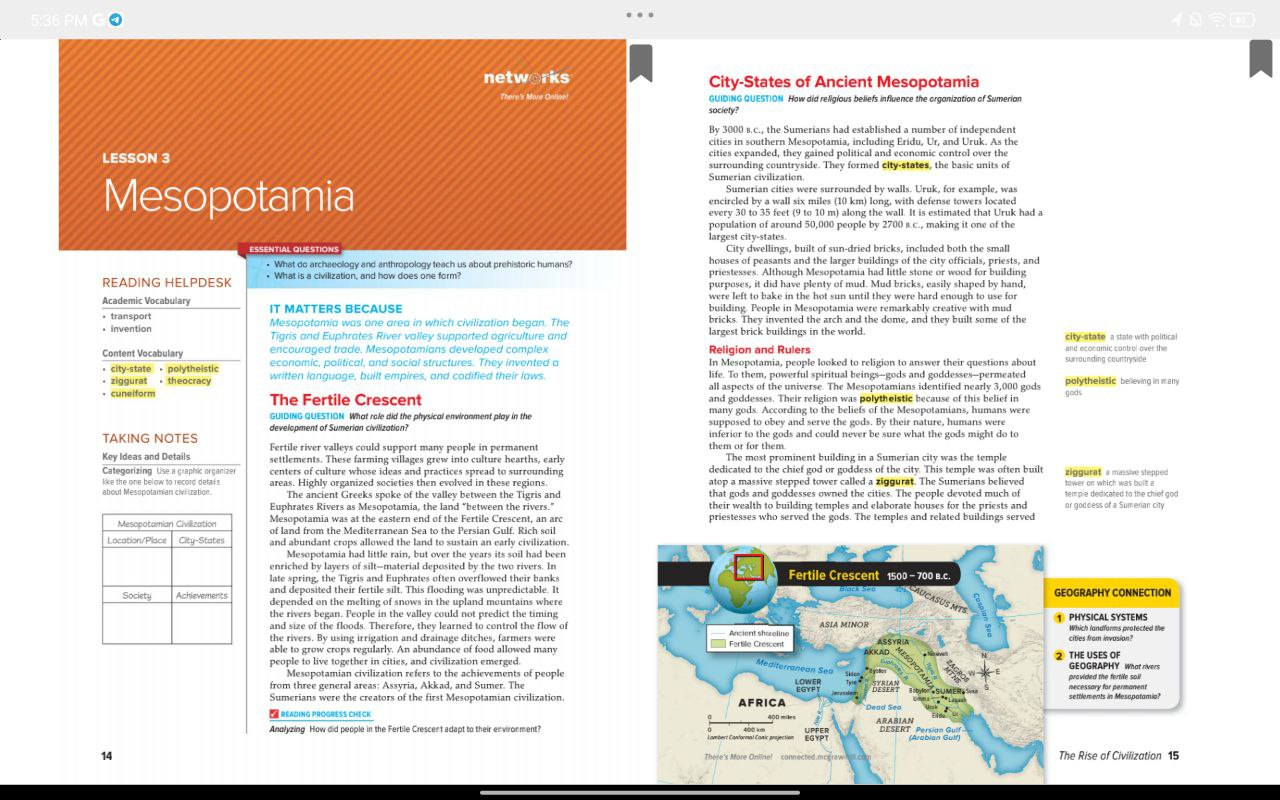
Essential Questions
- What do archaeology and anthropology teach us about prehistoric humans?
- What is a civilization, and how does one form?
Key Points
Importance of Mesopotamia
- Civilization Origin: Mesopotamia is recognized as one of the original cradles of civilization, facilitating the development of complex societies. The fertile land provided the necessary resources for agriculture, which enabled permanent settlements and social structures to form.
The Fertile Crescent
- Geographical Significance: The Fertile Crescent, particularly around the Tigris and Euphrates Rivers, was essential for supporting large populations. The region's environment allowed for efficient agriculture, which led to increased food supply, population growth, and the establishment of cities.
- Environmental Adaptation: People in the Fertile Crescent adapted their methods of farming and settlement to maximize agricultural yield and manage the challenges posed by the river ecosystems.
City-States of Ancient Mesopotamia
- Structure of City-States: By 3000 B.C.E., Sumerians established various city-states such as Eridu, Ur, and Uruk, each functioning independently but sharing cultural ties. City-states were fortified urban centers with structured governance and social hierarchies.
- Construction Materials: Sumerians primarily used sun-dried bricks for building. Although limited in natural resources like wood, they demonstrated ingenuity in construction using available materials.
Religion and Society
- Role of Religion: Religion played a pivotal role in organizing Mesopotamian society. People sought answers through spiritual beliefs and established a structured religious hierarchy with priests and priestesses.
- Ziggurats: Ziggurats, massive stepped structures, were constructed for worship. They reflected architectural innovation and the importance of religion in public life.
Vocabulary
| Term | Definition |
|---|---|
| city-state | a state that consists of a central city and its surrounding territory. |
| polytheistic | the belief in many gods. |
| ziggurat | a massive stepped tower built for the worship of gods. |
| theocracy | a system of government in which priests rule in the name of God. |
Additional Notes
- The existence of city-states and a structured society marked a significant shift from nomadic lifestyles to established civilizations.
- The interplay between religion and governance suggests a symbiotic relationship where authority was legitimized through divine right.
- Understanding Mesopotamian civilization provides insights into the foundational aspects of future societies and their developments.
Extended readings:
Notes on the Sumerians and the City of Ur
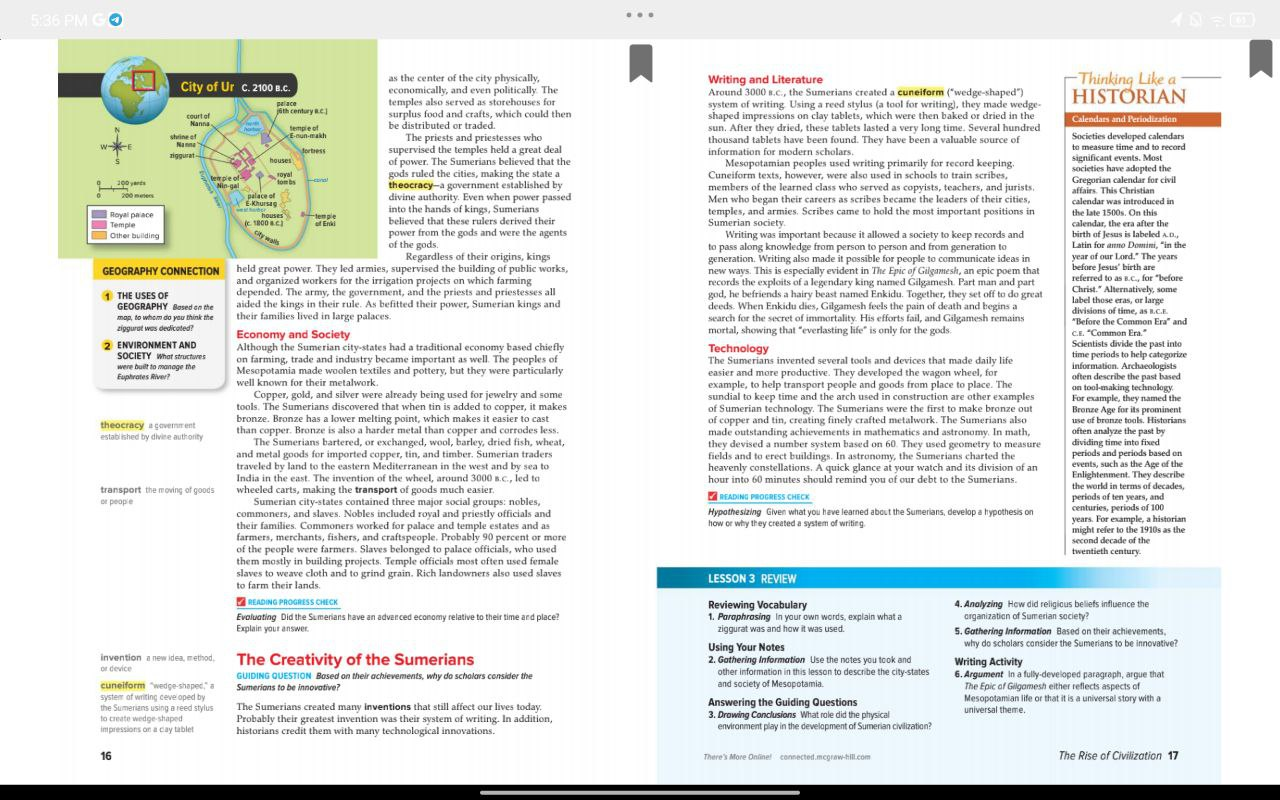
City of Ur (c. 2100 B.C.)
- Geographical Significance: The City of Ur was a central hub in ancient Mesopotamia, geographically positioned to control trade routes and agriculture.
- Thoughts: This positioning likely contributed to its economic power and influence in the region. The proximity to the Euphrates River would have facilitated irrigation, which was key for agriculture.
Economy and Society
- Traditional Economy: Sumerians utilized agriculture as their main economic base, relying significantly on farming, trade, and craftsmanship.
- Thoughts: The integration of different roles (farmers, artisans, clergy) created a complex societal structure and allowed for specialization and trade among different classes.
- Priestly Power: Priests held significant authority due to their perceived connection to the gods, governing aspects of daily life and temple activities.
- Additional Info: This power dynamic likely affected governance and societal organization, illustrating a blend of religion and politics where divine authority legitimized earthly rulers.
Writing and Literature
- Cuneiform System: Developed around 3000 B.C.E., it involved using a stylus to make wedge-shaped impressions on clay tablets, which served as a revolutionary method for record-keeping.
- Thoughts: The creation of cuneiform demonstrates the cognitive leap in human communication, enabling record-keeping, administration, and transmission of culture.
Technology
- Innovations: Sumerians invented various tools and techniques that advanced their daily life, such as bronze-making and geometrical measurements for building.
- Additional Info: Innovations like the potter's wheel, plow, and advanced metallurgy were crucial for agricultural efficiency and urban development.
The Creativity of the Sumerians
- Influence on Future Generations: Their inventions greatly influenced subsequent civilizations.
- Thoughts: Many foundational concepts in literacy, governance, and technology can be traced back to Sumerian innovations, highlighting their significant contributions to human history.
Lesson Review Summary
- Questions:
- How did geography aid in the organization of the Sumerian society?
- What role did cuneiform play in administrative efficiency?
Additional Points
- Hypothesis Development: Given their technological and cultural advancements, one might hypothesize that Sumerian influence shaped future civilizations' organizational and writing systems.
- Historical Significance: The findings from Sumer can provide important insights into the roots of modern civilization and societal structures.
Table of Key Concepts from the Sumerians:
| Concept | Description |
|---|---|
| Theocracy | Government based on divine authority |
| Transportation | Moving of goods and people |
| Invention | New ideas or methods impacting social structures |
| Cuneiform | Wedge-shaped writing system |
This synthesis of the information provides a comprehensive understanding of the Sumerians' contributions and the significance of the City of Ur in ancient civilization development.
Extended readings:
The Rise of Egypt
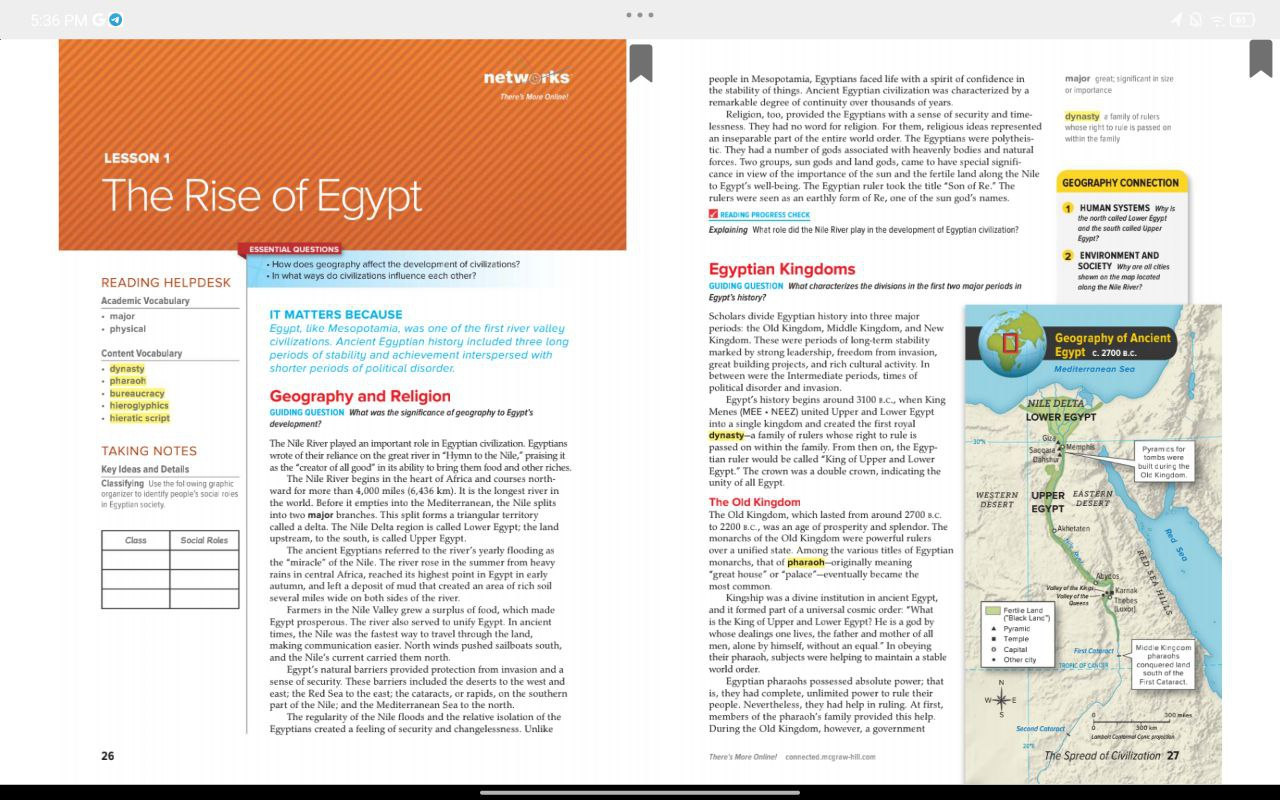
Reading Helpdesk
-
Academic Vocabulary
- major: significant in size or importance. Understanding the major events and concepts in ancient Egypt is crucial for grasping its impact on history.
- physical: relating to the natural features of the earth. Physical geography, such as the Nile River, played a pivotal role in Egypt's development.
-
Content Vocabulary
- dynasty: a family of rulers whose right to rule is passed down through generations. The stability of dynasties often led to longevity in governance.
- pharaoh: the title used for ancient Egyptian kings. Pharaohs held immense power and were considered both political leaders and divine figures.
- bureaucracy: a system of government in which most of the important decisions are made by state officials rather than by elected representatives. A well-structured bureaucracy helped manage the complex needs of society.
- hieroglyphics: the writing system used in ancient Egypt that involved symbols. Hieroglyphics were used for inscribing religious texts, official decrees, and monumental inscriptions.
- hieratic script: a simplified version of hieroglyphics used for writing on papyrus. This script facilitated faster and more practical communication.
Geography and Religion
-
Importance of the Nile River:
- The Nile River was crucial for the sustenance of Egyptian civilization. It provided water, fertile land for agriculture, and a means of transportation.
- The flooding of the Nile created fertile soil, which was vital for crop growth. This agricultural surplus supported population growth and the rise of cities.
-
Religious Significance:
- Egyptians believed in numerous gods who governed natural phenomena, such as the sun and the Nile. This led to a rich culture of mythology and religious practices.
- Pharaohs were seen as divine rulers, connecting religious authority with political governance. Their rule often emphasized the importance of maintaining order, or "ma'at", in their kingdoms.
Egyptian Kingdoms
- Divisions of History:
- Egyptian history is typically divided into three major periods: the Old Kingdom, Middle Kingdom, and New Kingdom. This division helps to categorize significant cultural, political, and economic changes.
Table of Egyptian Kingdoms
| Period | Key Characteristics | |-----------------|------------------------------------------------######| | Old Kingdom | Lasted from around 2700 to 2200 B.C.; characterized by the establishment of pyramids and centralized government. | | Middle Kingdom | A period marked by rejuvenation of arts and literature, as well as expansion in trade and military ventures. | | New Kingdom | Known for its imperial expansion and grandeur; pharaohs like Ramses II expanded territory significantly. |
Additional Thoughts
- The stability provided by strong dynasties allowed for extensive cultural development, such as advancements in art, architecture, and literature.
- Understanding the relationship between geography, agriculture, and religion helps to comprehend why ancient Egypt thrived for millennia.
- The influence of the Nile can be compared to how other civilizations developed around vital waterways, highlighting a common theme in human history.
Summary
The Rise of Egypt details the geographic and religious significance of the Nile, the role of dynasties and pharaohs, and the distinct periods in Egyptian history. These elements combined to shape one of history's most fascinating civilizations.
Extended readings:
Life in Ancient Egypt
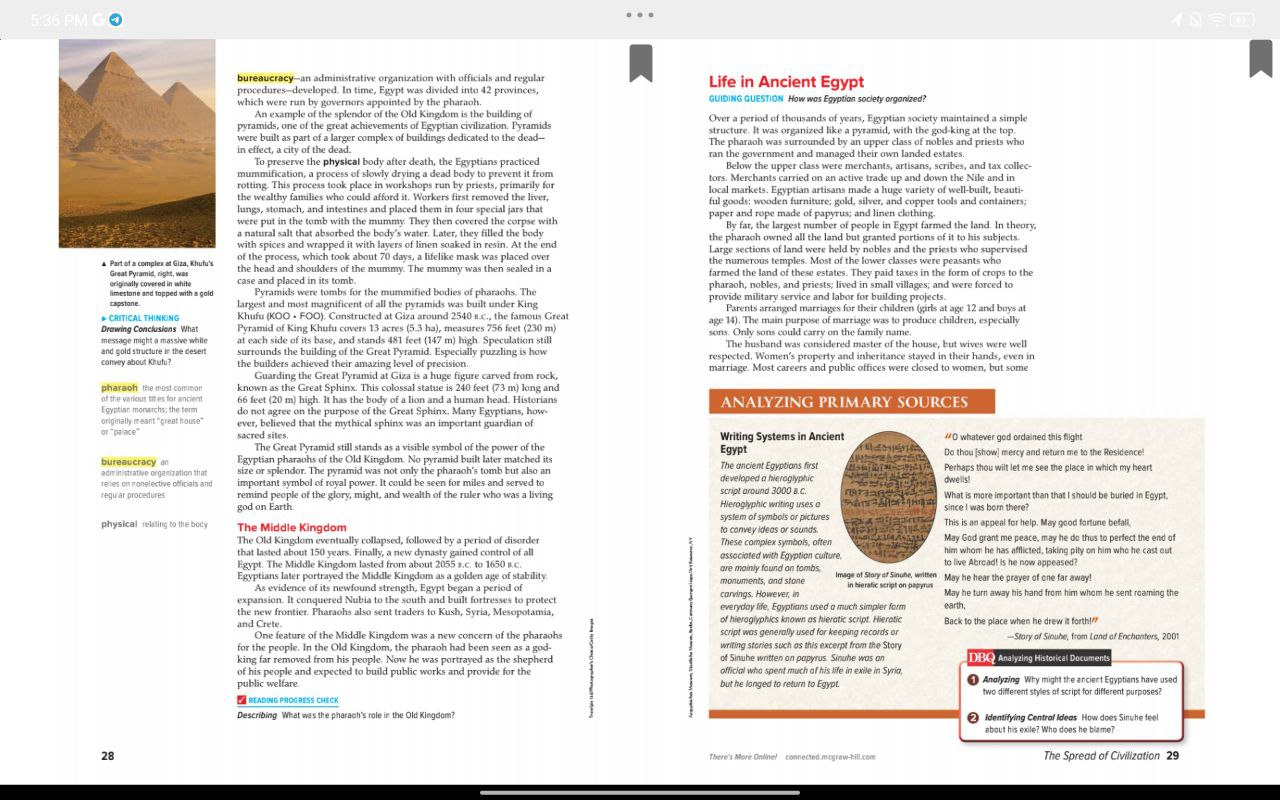
Bureaucracy
- Definition: An administrative organization with officials and regular procedures.
- Thoughts: This structure was essential for managing the complex society of ancient Egypt, particularly as it expanded its territories and responsibilities.
- Additional Info: The bureaucracy divided Egypt into 42 provinces overseen by governors appointed by the pharaoh, helping maintain order and efficiency.
Great Pyramid of Giza
- Construction: Built around 2540 B.C.E. under Pharaoh Khufu.
- Thoughts: The Great Pyramid exemplifies the advancements in engineering and architecture during the Old Kingdom.
- Additional Info: At 756 feet tall and covering 13 acres, it was a monumental achievement, as it required precise planning and vast resources.
Physical Preservation After Death
- Mummification Process: Involved several steps, including the removal of internal organs and the use of resins.
- Thoughts: This process reflects the Egyptians' beliefs in the afterlife and the importance of preserving the body for spiritual continuity.
- Additional Info: The body was wrapped in linen and placed in a sarcophagus, often accompanied by items for use in the afterlife.
Egyptian Society and Class Structure
- Pyramid Organization: Society structured like a pyramid with the pharaoh at the top.
- Thoughts: This hierarchical structure created clear divisions between classes, influencing social roles and responsibilities.
- Additional Info: The upper class included nobles and priests, while farmers and laborers formed the lower classes, often working the land owned by nobles.
Marriage and Family in Ancient Egypt
- Arranged Marriages: Common practice, especially for children at young ages.
- Thoughts: These arrangements typically aimed at strengthening alliances among families and ensuring social stability.
- Additional Info: Marriages often brought together families of similar wealth and status, with the husband typically being the head of the household.
Writing Systems in Ancient Egypt
| Writing System | Description |
|---|---|
| Hieroglyphics | Developed around 3000 B.C.E., used for religious texts and monumental inscriptions. |
| Hieratic Script | A simplified form of hieroglyphics for everyday writing. |
| Demotic Script | Used later, combined symbols and abstract forms for practical purposes. |
- Thoughts: The development of writing systems was crucial for record keeping and communication in administration, trade, and culture.
- Additional Info: These scripts reflect the literate culture of Egypt and its emphasis on documentation for both spiritual and practical needs.
Extended readings:
Egyptian Accomplishments and Peoples in the Eastern Mediterranean
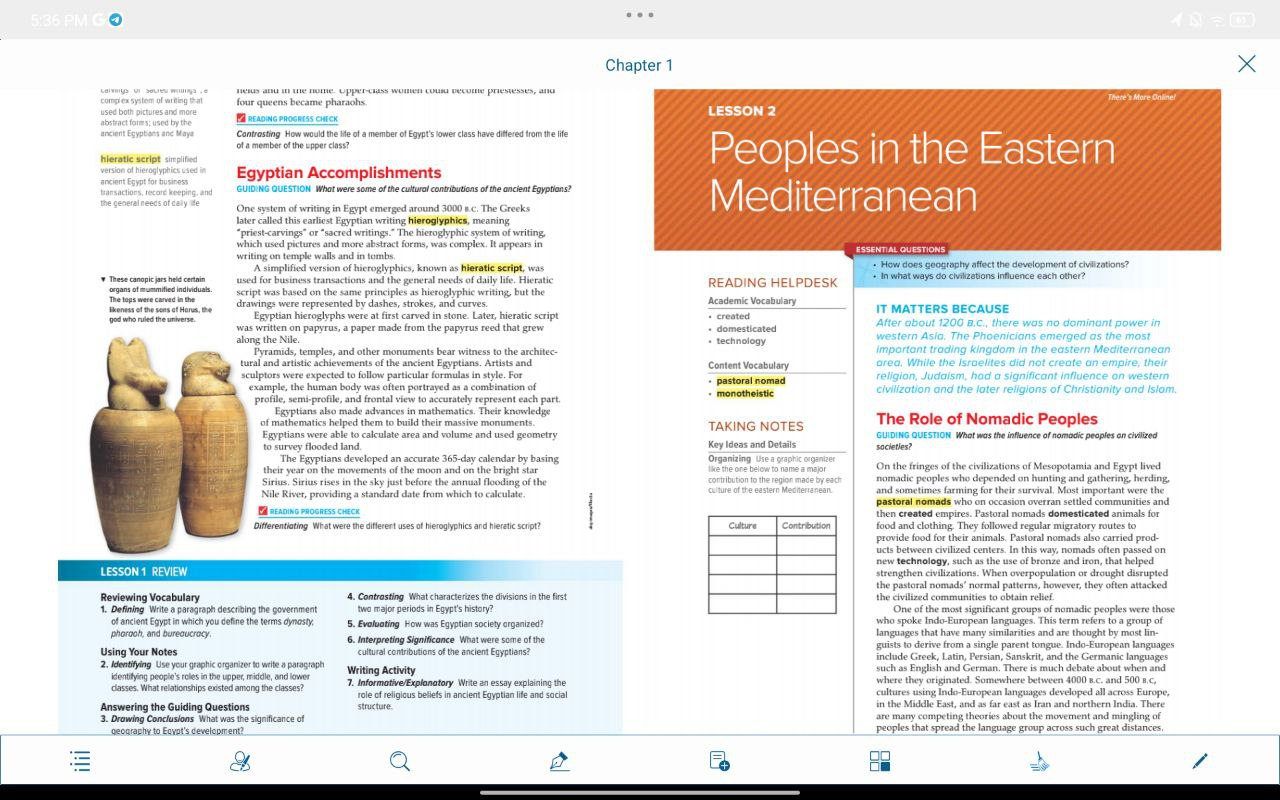
Egyptian Accomplishments
-
Hieroglyphic Writing:
- One of the earliest forms of writing emerged in Egypt around 3000 B.C., known as hieroglyphics.
- Thoughts: Hieroglyphics were not just a means of communication but also an art form reflecting the culture and beliefs of ancient Egyptians. The intricate designs hold historical significance.
-
Use of Hieratic Script:
- Derived from hieroglyphics, hieratic script was utilized for business transactions and daily life.
- Thoughts: The transition from hieroglyphics to more simplified scripts indicates the evolution of administrative needs and the literacy levels in Egyptian society.
-
Monuments and Architecture:
- The construction of pyramids and temples showcases architectural prowess and the advanced knowledge of geometry.
- Thoughts: These structures were not only tombs but also symbolic of the pharaohs' divine status, reflecting the intertwined nature of religion and governance in ancient Egypt.
-
Calendar Development:
- Egyptians developed a 365-day calendar to predict the annual flooding of the Nile.
- Thoughts: This innovation highlights the Egyptians' understanding of astronomical cycles and its practical application in agriculture and societal planning.
The Role of Nomadic Peoples
-
Cultural Influence of Nomads:
- Nomadic peoples lived on the fringes of civilizations and engaged in herding and gathering.
- Thoughts: Their adaptability and mobility allowed them to be essential in trade and cultural exchange, influencing the development of settled cultures.
-
Pastoral Nomadism:
- Pastoral nomads domesticated animals, which provided food and other resources vital for survival.
- Thoughts: This symbiotic relationship between humans and animals shaped lifestyle and societal structures, illustrating the impact of environment on culture.
Summary Table
| Culture | Contribution |
|---|---|
| Egyptian | Developed hieroglyphics, monumental architecture, advanced calendar system |
| Nomadic Peoples | Influenced trade, cultural exchanges, and domesticated animals for sustenance |
Extended readings:
Notes on Phoenicians and Israelites
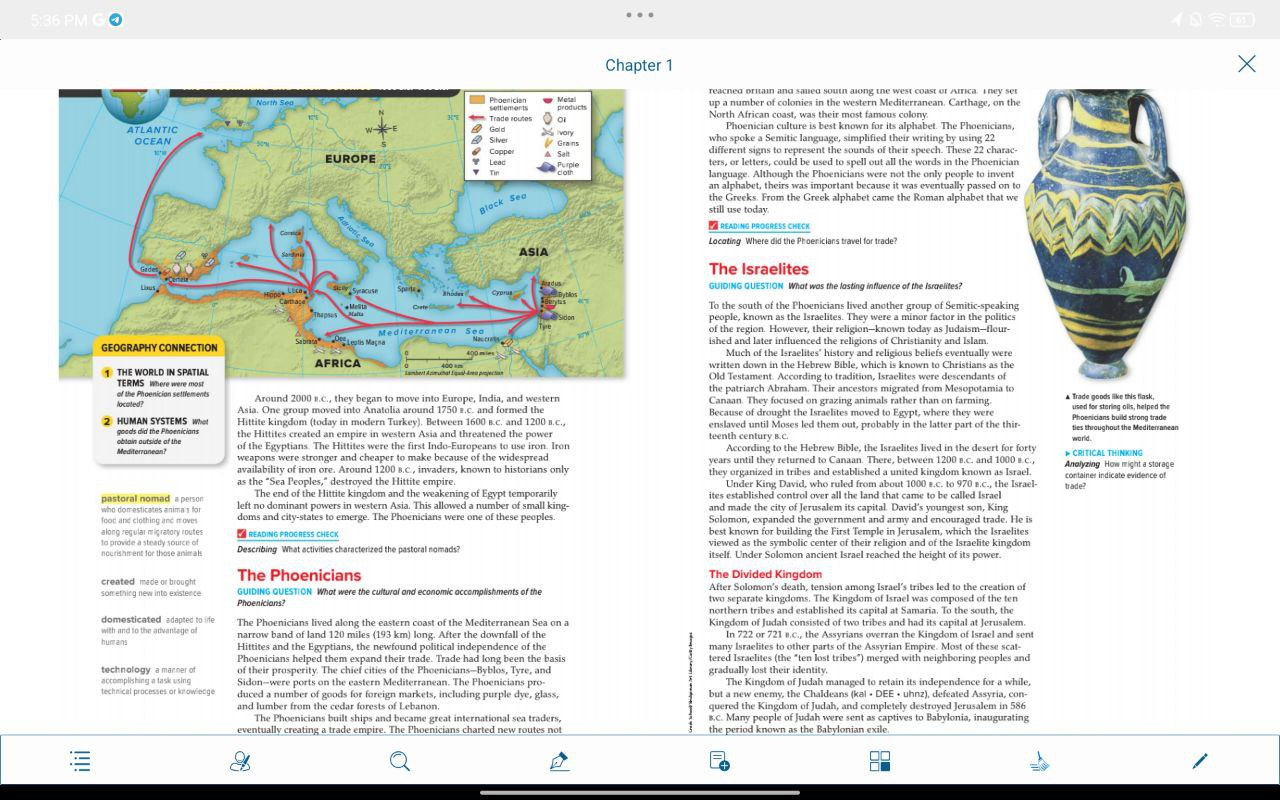
Geography Connection
- Phoenician Settlements: The Phoenicians established numerous settlements around the Mediterranean, including notable locations like Carthage. Their trade routes connected Europe, Africa, and Asia, facilitating cultural exchanges and economic growth.
- Thought: Understanding the geographical spread of the Phoenicians can reveal how trade networks influenced ancient civilizations.
The Phoenicians
- Economic Accomplishments: The Phoenicians are recognized for their innovations in trade and commerce, including the development of the alphabet that influenced Greek writing.
- Additional Info: The Phoenician alphabet comprised 22 characters and was pivotal in the transition from pictographic to phonetic writing systems, enhancing literacy and communication across cultures.
- Maritime Trade: They capitalized on their geographic advantage to dominate maritime trade, becoming skilled shipbuilders and navigators.
- Thought: Their expertise in sailing and navigation not only bolstered trade but also allowed for the exchange of ideas, technology, and culture with other civilizations.
The Israelites
- Cultural Influence: The Israelites, who lived nearby, contributed to the region's cultural landscape, particularly through their religious beliefs which later influenced Judaism, Christianity, and Islam.
- Additional Info: The religions have shared themes and narratives, showcasing the intertwining of cultural histories in the region.
The Divided Kingdom
- Historical Context: Following King Solomon's reign, the Israelite kingdom split into two: Israel to the north and Judah to the south. This division led to distinct political and religious developments.
- Thought: The division may have weakened their collective strength against external threats and altered their governance structures, impacting their historical trajectory.
Key Takeaway
The Phoenicians and Israelites played crucial roles in ancient Mediterranean dynamics, fostering trade, cultural interchanges, and contributing significantly to religious evolution. Their legacies are evident in modern writing and religious practices.
Extended readings:
Notes on Judaism and Minoan Civilization
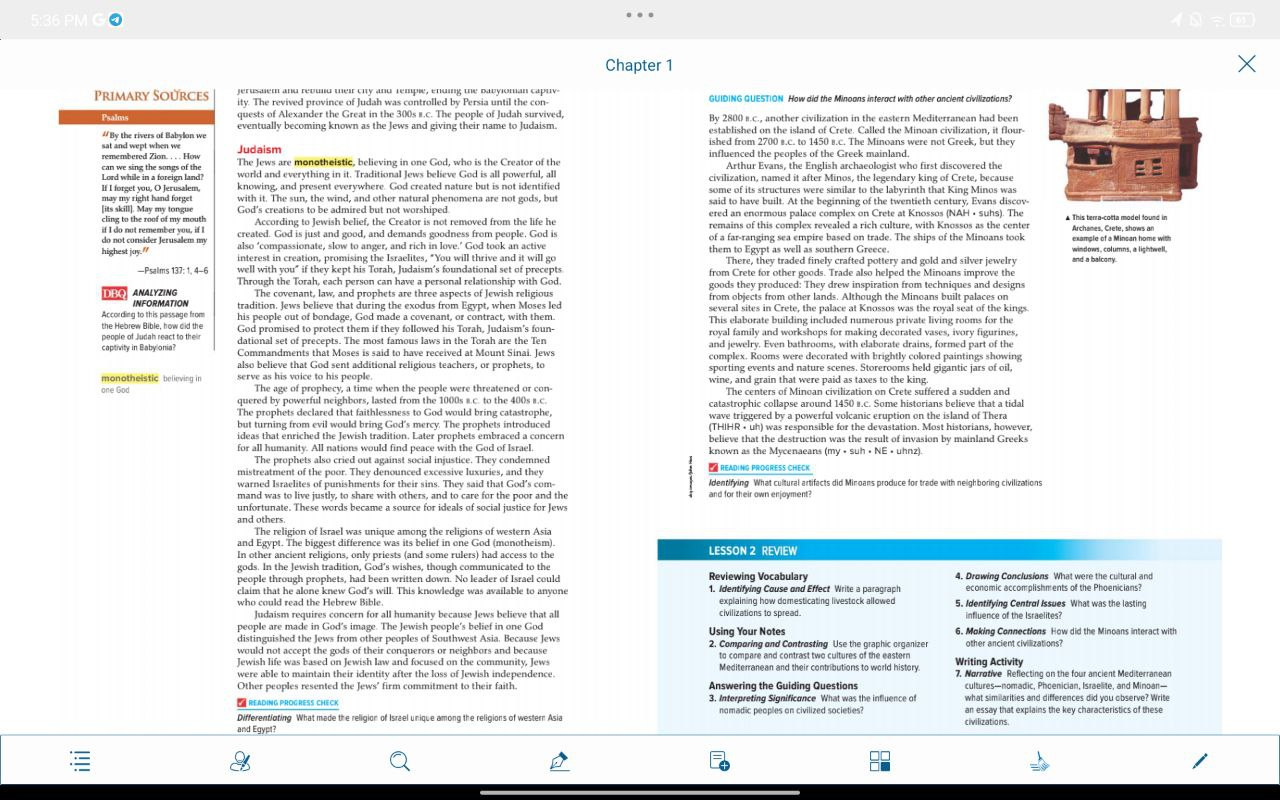
Judaism
-
Monotheism
- Judaism is characterized by the belief in one God, a fundamental aspect that distinguishes it from many ancient religions that worshipped multiple gods. This belief emphasizes the singular nature of God as the creator and overseer of the world.
-
God's Nature
- God is seen as powerful and compassionate, with an active interest in human affairs. This contrasts with the detached deities of other beliefs, reflecting a personal relationship that Jews can have with God.
-
Covenant and Law
- The concept of covenant plays a critical role, where God made agreements with the people of Israel, like the Exodus from Egypt. This idea emphasizes obedience to God's laws, which are articulated in the Torah.
-
Role of Prophets
- Prophets serve as intermediaries between God and people, delivering messages and guidance. Their warnings regarding moral behavior and social justice are central to Jewish teaching.
-
Concern for Humanity
- Unlike some ancient religions that prioritized the needs of a specific people, Judaism teaches concern for all humanity, advocating for social justice and ethical behavior towards others.
Minoan Civilization
- Interactions with Other Civilizations
- The Minoans had significant interactions with neighboring civilizations, engaging in trade that included a variety of goods and cultural exchanges.
- Cultural Influence
- They influenced and were influenced by other cultures through trade and interactions, which enriched their own civilization. This led to advancements in architecture, political structures, and technology.
- Collapse of Minoan Civilization
- Various factors contributed to the decline of Minoan civilization, including natural disasters (like volcanic eruptions) and potential invasions from mainland Greeks.
Summary of Key Concepts
| Concept | Description |
|---|---|
| Monotheism | Belief in a single, all-powerful God. |
| Nature of God | Active involvement in human affairs, compassionate. |
| Covenant and Law | Agreements between God and people, adherence to the Torah. |
| Role of Prophets | Intermediaries who convey God's messages and justice. |
| Concern for Humanity | Emphasis on social justice and ethical behavior for all. |
| Minoan Civilization | Thriving civilization that engaged in trade and cultural exchanges; experienced decline due to various factors. |
Lesson Reflection
-
Identifying Cause and Effect
- Understanding how agricultural practices influenced the development of civilizations is crucial in tracing historical trends.
-
Differentiating Characteristics
- Recognizing what makes Judaism unique helps in understanding its historical context and its impact on later cultures and religions.
-
Writing Activity
- A narrative could effectively convey the main characteristics of ancient Mediterranean civilizations, including their innovations, governance, and cultural legacies.
Extended readings: